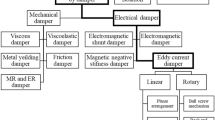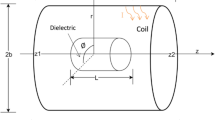Abstract
Tuned mass dampers (TMDs) have been widely used in recent years to mitigate structural vibration. However, the damping mechanisms employed in the TMDs are mostly based on viscous dampers, which have several well-known disadvantages, such as oil leakage and difficult adjustment of damping ratio for an operating TMD. Alternatively, eddy current damping (ECD) that does not require any contact with the main structure is a potential solution. This paper discusses the design, analysis, manufacture and testing of a large-scale horizontal TMD based on ECD. First, the theoretical model of ECD is formulated, then one large-scale horizontal TMD using ECD is constructed, and finally performance tests of the TMD are conducted. The test results show that the proposed TMD has a very low intrinsic damping ratio, while the damping ratio due to ECD is the dominant damping source, which can be as large as 15% in a proper configuration. In addition, the damping ratios estimated with the theoretical model are roughly consistent with those identified from the test results, and the source of this error is investigated. Moreover, it is demonstrated that the damping ratio in the proposed TMD can be easily adjusted by varying the air gap between permanent magnets and conductive plates. In view of practical applications, possible improvements and feasibility considerations for the proposed TMD are then discussed. It is confirmed that the proposed TMD with ECD is reliable and feasible for use in structural vibration control.
Similar content being viewed by others
Reference
Abe M and Igusa T (1996), “Semi-active Dynamic Vibration Absorbers for Controlling Transient Response,” Journal of Sound and Vibration, 198: 547–569.
Bae JS, Kwak MK and Inman DJ (2004), “Vibration Suppression of Cantilever Beam Using Eddy Current Damper,” Journal of Sound and Vibration, 284: 805–824.
Brownjohn JMW, Carden EP, Goddard CR and Oudin G (2010), “Real-time Performance Monitoring of Tuned Mass Damper System for a 183 m Reinforced Concrete Chimney,” Journal of Wind Engineering and Industrial Aerodynamics, 98(3): 169–179.
Chen ZQ and Liu GD (2009), “Pedestrian-induced Vibration Theory and Dynamic Design of Footbridges,” Engineering Mechanics, 26: 148–159. (In Chinese)
Dallard P, Fitzpatrick AJ, Flint A, Low A and Ridsdill-Smith, RM (2001), “The Millennium Bridge London: Problems and Solutions,” Structure Engineer, 79(8): 15–17.
Ebrahimi B, Khamesee MB and Golnaraghi F (2009a), “A Novel Eddy Current Damper: Theory and Experiment,” Journal of Physics D: Applied Physics, 42: 075001(1–6).
Ebrahimi B, Khamesee MB and Golnaraghi F (2009b), “Eddy Current Damper Feasibility in Automobile Suspension: Modeling, Simulation and Testing,” Smart Materials and Structures, 18: 015017(1–12).
Gou XF, Yang Y and Zheng XJ (2004), “Analytical Expressions of Magnetic Field Distribution of Rectangular Permanent Magnets,” Applied Mathematics and Mechanics, 25(3): 297–306.
Graves KE, Toncich D and Iovenitti PG (2000), “Theoretical Comparison of Motional and Transformer EMF Device Damping Efficiency,” Journal of Sound and Vibration, 233: 441–453.
Gu M, Chang CC, Wu W and Xiang HF (1998), “Increase of Critical Flutter Wind Speed of Long-span Bridges Using Tuned Mass Dampers,” Journal of Wind Engineering and Industrial Aerodynamics, 73(2): 111–123.
Gu M, Chen SR and Chang CC (2001), “Parametric Study on Multiple Tuned Mass Dampers for Buffeting Control of Yangpu Bridge,” Journal of Wind Engineering and Industrial Aerodynamics, 89(11): 987–1000.
Hoang N, Fujino Y and Warnitchai P (2008), “Optimal Tuned Mass Damper for Seismic Applications and Practical Design Formulas,” Engineering Structures, 30: 707–715. http://wwwintegratedsoftcom/papers/benchmark/bar_magnet/calculatorasp.
Kienholtz DA, Pendleton SC, Richards KE and Morgenthaler DR (1994), “Demonstration of Solar Array Vibration Suppression,” Proceedings of SPIE’s Conference on Smart Structures and Materials, Orlando, FL, 2193, 59–72.
Larose GL, Larsen A and Svensson E (1995), “Modeling of Tuned Mass Dampers for Wind-tunnel Tests on a Fullbridge Aeroelastic Model,” Journal of Wind Engineering and Industrial Aerodynamics, 54/55: 427–437.
Li CX (2000), “Performance of Multiple Tuned Mass Dampers for Attenuating Undesirable Oscillations of Structures under the Ground Acceleration,” Earthquake Engineering and Structural Dynamics, 29: 1405–1421.
Li CX and Qu WL (2006), “Optimum Properties of Multiple Tuned Mass Dampers for Reduction of Translational and Torsional Response of Structures Subject to Ground Acceleration,” Engineering Structures, 28(4): 472–494.
Li CX and Zhu BL (2006), “Estimating Double Tuned Mass Dampers for Structures under Ground Acceleration Using a Novel Optimum Criterion,” Journal of Sound and Vibration, 298(1–2): 280–297.
Lin CC, Chen CL and Wang JF (2010), “Vibration Control of Structures with Initially Accelerated Passive Tuned Mass Dampers under Near-fault Earthquake Excitation,” Computer-Aided Civil and Infrastructure Engineering, 25: 69–75.
Marano GC, Greco R, Trentadue F and Chiaia B (2007), “Constrained Reliability-based Optimization of Linear Tuned Mass Dampers for Seismic Control,” International Journal of Solids and Structures, 44(22–23), 7370–7388.
Palomera-Arias R, Connor JJ and Ochsendorf JA (2008), “Feasibility Study of Passive Electromagnetic Damping Systems,” Journal of Structural Engineering, 134: 164–170.
Setareh M and Hanson RD (1992), “Tuned Mass Dampers to Control Floor Vibrations from Humans,” Journal of Structural Engineering, 118(3): 741–762.
Priya S and Inman DJ (2009), Energy Harvesting Technologies, Springer.
Setareh M, Ritchey JK, Murray TM et al. (2007), “Semiactive Tuned Mass Damper for Floor Vibration Control,” Journal of Structural Engineering, 133(2): 242–250.
Sodano HA and Bae JS (2004), “Eddy Current Damping in Structures,” The Shock and Vibration Digest, 36(6): 469–478.
Sodano HA, Bae JS, Inman DJ and Belvin WK (2005), “Concept and Model of Eddy Current Damper for Vibration Suppression of a Beam,” Journal of Sound and Vibration, 288(4–5): 1177–1196.
Sodano HA, Bae JS, Inman DJ et al. (2006), “Improved Concept and Model of Eddy Current Damper,” Journal of Vibration and Acoustics, 128: 294–302.
Sodano HA and Inman DJ (2008) “Modeling of a New Active Eddy Current Vibration Control System,” Journal of Dynamic Systems, Measurement, and Control, 130(2): 021009(1–12).
Soong TT and Spencer BF, (2002), “Supplemental Energy Dissipation: State of Art and State of Practice,” Engineering Structures, 22: 243–259.
Spencer BF and Nagarajaiah S (2003), “State of the Art of Structural Control,” Journal of Structural Engineering, 129(7): 845–856.
Wang SQ, Li HJ, Ji CY and Jiao GY (2002), “Energy Analysis for TMD-structure Systems Subjected to Impact Loading,” China Ocean Engineering, 16(3): 301–310.
Wilkinson SM and Knapton J (2006), “Analysis and Solution to Human-induced Lateral Vibrations on a Historic Footbridge,” Journal of Bridge Engineering, 11(1): 4–12.
Xu YL, Kwok KCS and Samali B (1992), “Control of Wind-induced Tall Building Vibration by Tuned Mass Dampers,” Journal of Wind Engineering and Industrial Aerodynamics, 40(1): 1–32.
Author information
Authors and Affiliations
Corresponding author
Additional information
Supported by: State Key Program of Natural Science Foundation of China Under Grant No. 50738002
Rights and permissions
About this article
Cite this article
Wang, Z., Chen, Z. & Wang, J. Feasibility study of a large-scale tuned mass damper with eddy current damping mechanism. Earthq. Eng. Eng. Vib. 11, 391–401 (2012). https://doi.org/10.1007/s11803-012-0129-x
Received:
Accepted:
Published:
Issue Date:
DOI: https://doi.org/10.1007/s11803-012-0129-x




